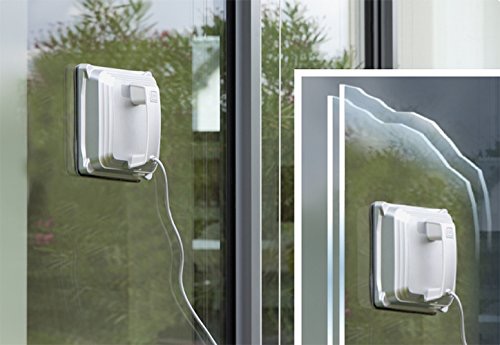Like most homeowners, you probably just let smudges and filth settle on your windows and wait for the rain to wash them away. Who can blame you? Window cleaning is not just a tedious task but dangerous as well. Imagine if you have a two-story home or live on the 15th floor of an apartment building and have to clean your windows.
Fortunately, the advancement in technology paved the way for robots that can assist you with the arduous task. A high-tech window cleaning robot is a great way to keep your glass clean, eliminating the risk of injuries or falling out of your window.
Although its technology is not always accurate, the best window cleaning robot can get the job done minus all the fuss. So, if you’re looking for a hassle-free way to keep your windows sparkly clean, keep on reading to find out how these automated window cleaners work.
How A Window Cleaning Robot Works
A robot window cleaner enables you to wash your outdoor and indoor windows with ease, even those that are hard to access. This smart gadget can typically clean an entire window from end to end. And then, it’ll alert you once it’s done with the task.
The window cleaner combines the latest cleaning technology with automated movement. It’ll stick to your window with the help of a motor-powered suction, to clean the entire window automatically. This enables you to tackle those high windows that you won’t normally be able to reach with manual cleaning methods.
Most robotic window cleaners can handle almost all window types. And although some have the same basic features, some units like the Winbot 730 offer different height restrictions, cleaning, methods, and functionalities. This model even boasts of a frameless window detection system for washing glass doors and windows easily. Check this illustration out to learn more.
Features To Consider
Controls and cleaning modes
Your robot window cleaner may come with several cleaning modes. These usually comprise of cleaning paths or directions it can go. Furthermore, you can control most units via a smartphone app or remote control.
This is pretty convenient since you can sit back and relax while your robot can do all the window cleaning for you. And if you see that your window requires a few more passes, just use the remote control to choose the appropriate cleaning mode.
Magnetic connectivity or suction
Robotic window cleaners either have a motor-powered suction or magnetic connectivity. With magnetic connectivity, you need to attach another magnetic piece on your window’s opposite side. In some instances, this can be a bit challenging.
On the other hand, suction offers more convenience since you only need to place your robot on your window. Still, there’s a possibility that this connection type may fail. Therefore, you may need a safety cable attached to your window washing robot to ensure that your device will not fall off while doing its job.
Cleaning process
While the majority of robotic window washers utilize brushes or cleaning cloths, some may also use a squeegee, ensuring your windows are streak-free.
Moreover, the number of pads or brushes your robot has will depend on its model. Additionally, your robot may require you to fill it up with a window cleaning liquid before letting it go to work. Some units may also have the capacity to clean mirrors, doors, shower walls, and other types of surfaces.
Size
Size does matter, especially if you have wide surfaces to clean. So choose an automated window cleaner large enough to cover them before its battery runs out.
Battery life
Many of these cleaning gadgets have a shorter battery lifespan. In a single run, these robots are capable of cleaning at least 10 average windows.
So depending on the model you have, you can expect these machines to last more than 30 minutes or less than 15 minutes. If your home has a lot of windows, make sure to opt for a model with a longer battery life. But keep in mind that this may also mean you have to pay a little bit extra.
Dry and wet cleaning pads
This is one of the features that separate models with a higher price tag from cheaper ones. More expensive robots typically come with microfiber pads for dry and wet cleaning.
Wet pads are perfect when you want to use a cleaner, while dry pads are great for removing dust. These pads will not leave small fibers behind on your windows. Likewise, they are reusable and washable.
Power cable
If you’d rather choose a window cleaning robot with a power cable, then look for a unit with ample cable length. You can easily remedy a short cable with a top-notch extension cable, but you want to avoid a messy wire set up as much as possible.
Cost
The price of entry-level robotic window cleaners can range from $99 to $159. However, these are basic models and do not provide you with the convenience of remote control features.
Meanwhile, those that cost between $175 and $300 can provide you with more attractive features. But if you want a unit that works faster, offers numerous ways to control it or has advanced sensors, expect to pay around $350 to $500 or up. Some even come with a built-in water reservoir so that you don’t have to spray your windows.
How To Use A Window Cleaning Robot
Before getting your robot to start cleaning, clear off a spot on your window. Then, do the following steps:
Some models are cordless while some are not. If you have a corded unit, make sure that its power cable is hooked up properly with a lot of slack for it to move around without problems. You don’t want the cable to pull the robot down and break it.
Place your window cleaning robot and hold it even with the windowpane, then press its power button. Most models will let out a beep after three to five seconds, while some have LED lights that will go off. After this, your unit will begin climbing up your window and start cleaning.
When it’s done with its task, the robot will stop on its own.
These cleaning gadgets can also do a good job at cleaning windows with an odd shape. They have built-in smart sensors that can determine the next spot to tackle. Once they see that every spot has been cleaned, it will shut off automatically.
Robotic window cleaners like the Ecovacs Winbot 950 Window Cleaner are also easy to set up and use. It’ll take care of all the dirty work for you and give you more time to take care of other chores around the house. Watch how easy it is to use and how efficient the Winbot 950 is at cleaning windows.
Advantages Of Robotic Window Cleaners
An easy solution
Simply tap its power button and it’ll start to work its way across your windowpane. Additionally, most robot window cleaners can map out your whole window and will move to all corners, giving it a thorough clean. Hence, you don’t have to worry about those hard to reach spots. Some machines operate using an internal battery, allowing them to move freely without worrying about messy cables.
Minimal effort
Most window robot cleaners are lightweight. You can easily pick your unit up and attach it to your window on your own. When it’s done with a window, simply remove the robot, and attach it to another spot.
These automated window cleaners also come with a smart technology, where their sensors can detect glass and window edges. This ensures that the smart appliance will not off even if you have edgeless windows.
No more streaks
If you don’t use the right technique, you’ll end up with windows full of unattractive streaks. They may look clear and clean, but once they are hit by sunlight, you’ll see all the cleaning movements you made on your windows.
This is one less thing you need to worry about when using a window cleaning robot. It won’t leave your windows with any traces behind since it moves in a zigzag pattern. You can even find models with a vibrating cleaning head that scrubs the window to get rid of dirt even more effectively.




